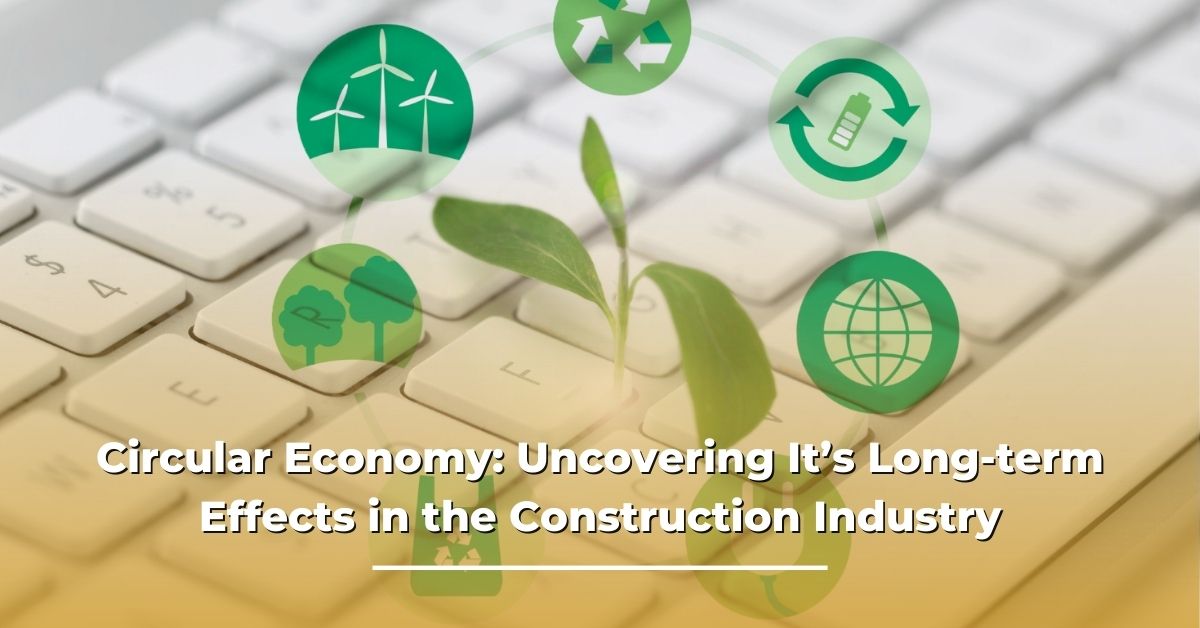It is no secret that the construction industry is one of the biggest causes of pollution and environmental damage. Because of bad practices that persisted for decades or even centuries, our environment is reeling and it will have long-term negative economic, environmental, and social problems. If we do nothing, we will face severe consequences such as severe natural hazards which will irreversibly change our lives for the worse. Fortunately, we can have a healthy balance between progress the progress of human civilization and natural harmony through a circular economy.
In this article, we will define what Circular Economy is and what are its long-term effects on the construction industry.
What is Circular Economy?
Circular economy (CE) is a restorative economic system that aims to fight climate change, prevent loss of biodiversity, reduce waste, and provide green jobs while boosting economies. CE does this by keeping materials, products, and services in circulation for as long as possible according to the US EPA.
In our current economic system, we extract materials from the planet, make products out of them, and throw away waste. This linear process produces a lot of waste, which will become pollutants that harm people and the environment.
With CE, we can stop this by transforming even our waste into useful products. A good example of this is the use of recycled plastic as a construction material.

What are the Long-term Effects of the Circular Economy on the Construction Industry?
Reduced Waste Generation
CE prioritizes structural design that uses fewer materials that are easily disassembled, reused, and recycled at the end of their life. It also promotes reduced reliance on non-renewable materials, usage of renewable building materials, and green building techniques.
By embracing CE, the construction can significantly reduce global CO2 emissions from building materials by 38% in 2050.
Increased Resource Efficiency
By reducing demand for non-renewable resources such as steel, aluminum, cement, and plastic, the construction industry would be more resilient to the price volatility of raw materials and supply chain disruptions.
On top of that, being more resource efficient will help the construction industry to save costs by reducing waste disposal costs, material costs, logistical costs, and energy and water costs.

Challenges
Aside from benefits, implementing a circular economy in the construction industry creates new challenges too; such as:
- Adoption of new technologies and materials
- Development of new business models
- Availability of markets and infrastructure to support the reuse and recycling of materials
- Regulatory compliance
- Stakeholder engagement
- Measuring the effectiveness of circular economy initiatives
- The time it would take to develop and implement all necessary CE practices in the construction industry
Enhanced Reputation
In recent years, people’s buying habits have changed towards supporting companies that promote sustainable practices and sell products made of sustainable materials. As a result, businesses that are adapting or supporting CE, eco-finance, and other sustainable practices could benefit from the improved reputation and customer loyalty. This is especially true with the majority of Gen X, Millennials, Gen Z, and other future generations who are more willing to spend 10% more or above on products that promote sustainability.
The long-term climate and environmental problems can be fixed if we support sustainable initiatives such as the circular economy. This regenerative and sustainable economic system has great long-term benefits that could support social, economic, and environmental harmony.
Do you want to see more content like this in the future? Subscribe to Pinoy Builders for FREE today and stay in the loop for the latest news and updates on the Philippine construction industry!
Sources:
- What is a Circular Economy? | US EPA. (2022, September 29). US EPA. https://www.epa.gov/recyclingstrategy/what-circular-economy
- Reimagining our buildings and spaces for a circular economy. (n.d.). https://ellenmacarthurfoundation.org/topics/built-environment/overview
- BSI. (n.d.). Circular economy. Retrieved March 1, 2023, from https://www.bsigroup.com/en-PH/topics/sustainability-and-circular-economy/
- Finding and utilising “waste” materials for construction purposes. (n.d.). https://ellenmacarthurfoundation.org/circular-examples/finding-and-utilising-waste-materials-for-construction-purposes










